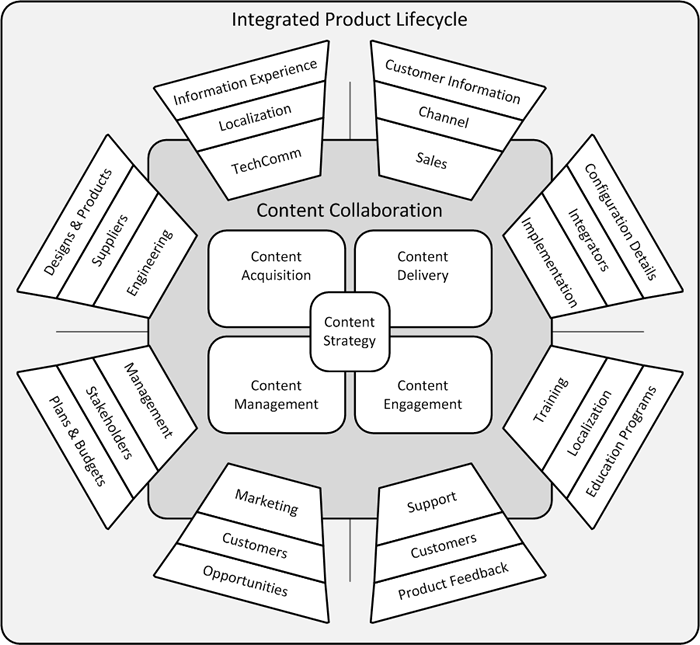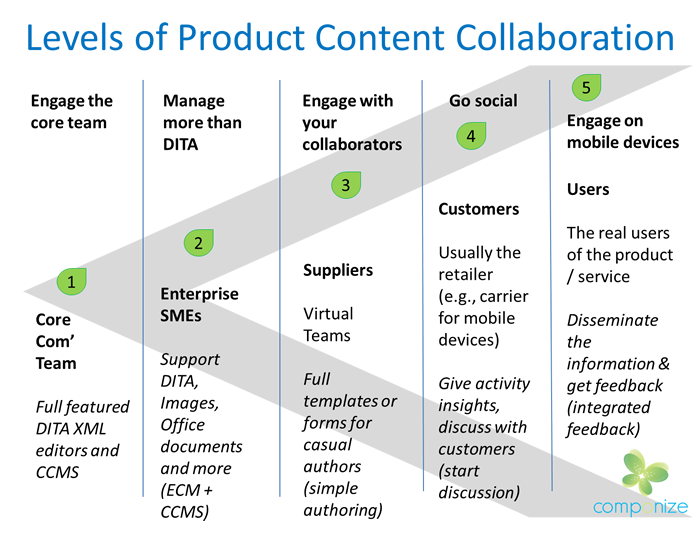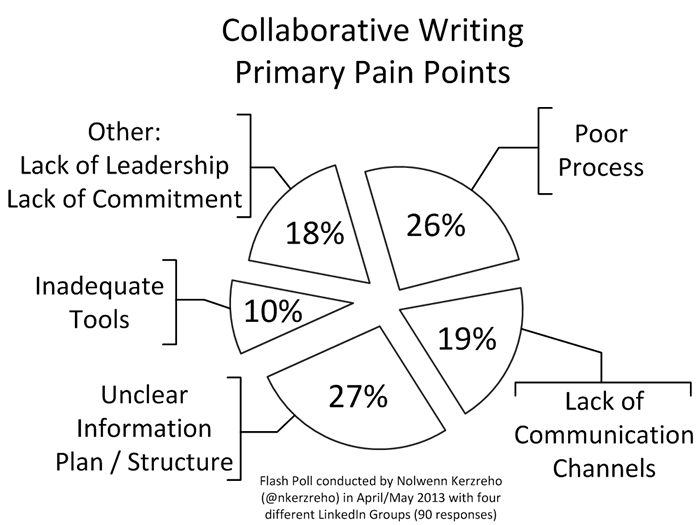A Q&A with Nolwenn Kerzreho and Joe Gollner
Editor’s Note: Jacquie Samuels caught up with Nolwenn Kerzreho and Joe Gollner as they were preparing for their LavaCon post-conference workshop in late October, to discuss how content collaboration and integrated product development are changing the face of content creation and management.
1. How do you define collaboration, in the context of content and product development?
NKE: Whenever several people act on the same piece of content, collaboration takes place.
For technical communicators, the fact that multiple people will be editing a piece of content means that individual authors are no longer completely in charge of the process from end-to-end for an entire deliverable. This can be a big change. Individual authors must come to see that they are now part in an information development process that involves many different contributors.
There are other changes as well, for example within a more collaborative setting, the information development team will be called upon earlier and earlier in the product development process – for example at the moment the product requirements are framed and the user stories are drafted. Here the ability of communicators to contribute clarity to the design baseline can have major benefits.
JAG: The move to a process-oriented view of content creation, instead of an individual-oriented view, is a key shift. I think it is an opportunity for technical communicators because it highlights the fact that there are additional communication skills that are essential to the process. Not only will communicators need to be able to write, they will need to be able to help other people to write. This will call for delicate facilitation and leadership because often the other contributors will be subject matter experts whose primary work may not have, in the past, required that they contribute to content creation in this new, more collaborative way.
From the perspective of product development, collaboration follows an identical path. Given the technical sophistication of products today, a myriad of specialists are expected to contribute to the design and development process. More often than not these days, with product companies distributing work around the world, product collaboration will actually take the form of content collaboration.
2. Where does collaboration fit into the content lifecycle? How can an Integrated Product Team (IPT) address the content lifecycle?
NKE: As collaboration is expanded across the complete content lifecycle in an organization, information developers get a birds-eye view of organizational content that in the past was always locked away in distinct silos. This gives them a great opportunity to analyze a wider spectrum of content resources, often in their original forms. From this analysis, the information developers discover new opportunities for repurposing content and streamlining its development. The information developers also identify opportunities to exercise and apply new skills as they start to play an increasingly important role in facilitating collaboration across the organization and its product lifecycles.

JAG: Ideally, collaboration occurs throughout the content lifecycle–from the initial planning and design of the information through to its review and finalization, and even to its ongoing revision. As our illustration tries to show, content collaboration runs throughout the content lifecycle and it can be leveraged to connect all phases of the product lifecycle.
Within the product lifecycle, the tendency for content to collect in silos has been a major impediment to improvement. The work that communicators can do to bridge the gaps between these silos may not be immediately appreciated by the specialists working in these different silos but the cumulative effect that streamlined content collaboration across the product lifecycle can be massive and its benefits will become pretty obvious.
The concept of an Integrated Product Team (IPT), introduced in your question, probably needs a little attention. As a concept, the IPT emerged as one of the ideas associated with Lean Manufacturing and Concurrent Engineering. Basically, the idea is that product quality is greatly improved if representatives from all of the lifecycle stakeholders, from design and manufacturing through to documentation and support, are involved in all aspects of product design and development from the very beginning. As a tactic, IPT was introduced as a way to break down the disciplinary walls between departmental silos. Our discussion of content collaboration in the product lifecycle falls squarely into the same tradition and it is another tactic to be deployed.
3. What factors are leading organizations to embrace collaboration?
NKE: Basically, the growing need for collaboration comes along with several prominent trends.
In the information development industry, more and more “tech writing” teams are becoming “information experience” (IX) teams. And with this change, many of these teams are being placed within the larger Customer Experience business area. Teams that have made this shift are encouraged to adopt a customer-centric viewpoint and to integrate everything an organization does around that perspective. Information developers become responsible for establishing an integrated view of information that previously would have been hidden within silos. In order to effectively fulfill this role, information developers need to collaborate with stakeholders across the organization to meet this new goal.
Another trend that is raising the profile of collaboration is the growing adoption of modular content. Modular content strategies, such as those seen in DITA, actively create new opportunities for collaboration. We will touch upon this in more detail when we come to discuss the role that tools can play in facilitating collaboration.
What we can say at this time is that a number of technology trends are simply making collaboration much easier. As an example, let’s consider the rise in cloud-hosted business applications that allow contributors to access and work on content from anywhere within an organization–or for that matter from anywhere at all. At the very least, this can help break down the “content-stuck-in-a-local-drive-somewhere” syndrome that we have all encountered in the past.
JAG: A key trend in product development, and this is true of consumer products and major systems, is towards building products from standardized components. These components are assembled in various ways to produce a wide range of product variants and this allows companies to cost-effectively address many different markets. This approach also allows product companies to tap into ever more specialized suppliers providing smaller and smaller reusable components. When you combine this with the fact that the competitive pressure being felt by these companies grows daily, you have a real impetus towards collaborative work models. In fact, collaboration by all product stakeholders, from marketing through to support, is now the only way to keep up with demand. All this makes maximizing the efficiency and responsiveness of the content collaboration process, with its ability to reach across silos and across supply chains, a critical business priority.

4. How is content collaboration the key to being a more productive doc team?
NKE: One obvious answer is that sharing previously created and validated content, instead of rewriting it, is a huge improvement over past approaches. It offers faster deliveries and, ultimately, better time-to-market for product information. And this is something that executive management immediately appreciates as an important productivity improvement. Now it’s important to emphasize that collaboration can only make this type of contribution to productivity improvement when the key impediments, or stumbling blocks, to effective collaboration within organizations are removed.
JAG: One thing that I have seen within product documentation teams is that a more collaborative approach to content creation can help to greatly improve the way the team interacts with other stakeholders in the product lifecycle, for example with the engineering group. These teams indicate that, in the past, they had to chase people around looking for details needed in the documentation. As better collaborative processes were put into place, more and more of this information was being made available as an automatic part of an improved product development environment. Even better, as the tools were aligned with the process and as subject matter experts became more comfortable with making specific contributions, the content being provided to the documentation team was becoming more and more directly reusable. So while getting the collaborative process and environment in place takes effort, there are definitely improvements from the perspective of the documentation team. And there are larger improvements too. The documentation in this new mode is far more responsive to changes being made in the product as new versions are released. This makes the entire product lifecycle more effective, which benefits everyone.
5. What are the biggest hurdles in collaborative content creation?
NKE: I conducted four flash-polls from April 10 to May 17 2013 while preparing a presentation for Center for Information Development Management (CIDM) CM Strategies / DITA North America conference.
Respondents were asked to identify their primary pain point when it comes to collaborative writing. Ninety professionals responded and the poll was also very heavily commented. The possible answers, and the percentage of the votes received by each, are shown below:

I was glad to find the tools are not perceived as a hindrance to collaboration. Rather, they enforce and support the processes, automate assignments, and notifications. However, if the basics of good information structures and clear processes are missing, technology will not be able to help much.
More respondents identified Unclear information plan/structure as their biggest pain point. This underscores the need for the information architect to implement well-designed authoring plans and information structures so that content collaborators can see how their contributions fit in.
The comments provided on the poll showcased the passion of many of communication professionals who strive to make content collaboration work in their organizations. Many of the comments were associated with the possible response of “Other,” and here people indicated a lack of management support for collaborative practices as a key challenge. Other comments identified a lack of willingness of people to commit the time to make collaboration work.
JAG: The flash poll did highlight several important considerations. As Nolwenn noted, the volume and vigor of the comments provoked by the poll were particularly interesting. I find the comments about the lack of management support and weak leadership to be very instructive. And I would interpret the references to unwillingness of team members to collaborate as another reflection of the failure of leadership to provide the basic conditions within which collaboration can occur.
6. What does your experience working with IPTs and collaborative content creation show as the best ways to overcome these hurdles?
NKE: There is no successful change in collaborative practices without the adoption of a) a new frame of mind and b) new processes. Change management can be hard. Some people will never wrap their minds around the fact that they don’t own a document anymore. Others may feel they are being drafted into a process in which their value will no longer be visible.
One key to making the change is to make it as easy as possible for the information developers and collaborators. It is even more critical with casual authors, where you want to maximize the time spent on creating high-value content and not on formatting. The tools should not get in the way, but rather should support the team effort toward its goal.
Training will help the team, but continuous communication is even more important. Put into place simplified processes and bring clarity to the team as to their changing roles. And ensure that everyone understands what the goals are behind the move towards a new collaborative approach – the delivery of better information that can be created and updated much more quickly and that helps product users be more effective.
JAG: I would place a double emphasis on Nolwenn’s point about change management being hard, and suggest that this is where management needs to step in and provide the necessary leadership. And we must remember that the collaboration we are talking about will cut across an organization and may extend well beyond its borders. This means that the leadership needed to facilitate the changes in behavior will either come from executive management or from business unit managers who can reach out to their colleagues in other units to coordinate the change process. As the comments received on the flash poll indicate, this may be exactly the area where most organizations have a serious gap in their management capabilities.
7. What tools or processes can help us collaborate more effectively? (And do we need a tools budget to get there?)
NKE: While they can’t solve all the problems, tools can be extremely helpful in organizing content resources and making them more findable for all stakeholders, from information developers to managers and, downstream, for consumers as well.
A shared repository is pretty much mandatory so that all contributors can share and reuse information, receive notifications from processes, task assignments, quality reports, and other status indicators.
 The tools can also help by providing a common project space so that teams can share ideas about the content being developed and about the process, the roles and the guidelines being followed. It is very important that people feel that they are part of the overall process and not just a cog in the wheel. With the right collaboration space available to them, all participants can feel that they can raise questions and ultimately see changes made in the process.
The tools can also help by providing a common project space so that teams can share ideas about the content being developed and about the process, the roles and the guidelines being followed. It is very important that people feel that they are part of the overall process and not just a cog in the wheel. With the right collaboration space available to them, all participants can feel that they can raise questions and ultimately see changes made in the process.
Before the introduction of more structured approaches to collaboration, content processes within organizations were often informal and depended on working-level collaboration between people who had regular contact between each other. Introducing more structure into the collaborative effort, and deploying supporting tools, can make content processes much less time-consuming for individual participants and can help people collaborate with those who they may have never met before.
Introduction of structured approaches is key, and this breaks down into usable information structures and clear process guidance. The tools can work support structures and processes and can give people a point of reference as they interact with new groups of stakeholders. Adopting a standard such as DITA can help with the structured approach. DITA in particular offers some benefits in this context, because it uses proven tactics for handling modular content and for defining common information structures.
However, this does not mean that you can wave a DITA magic wand and automatically make collaboration happen. Even with the adoption of DITA, the organization must make important decisions about how the standard will be applied to an organization’s content and how its processes will be adapted. DITA is really only one of the tools that an organization can leverage. An organization that wishes to be successful in moving to a more collaborative approach to content creation and management within the context of its product lifecycles, has to commit to a number of really hard tasks, such as implementing effective training, communicating clear project goals and a realistic change roadmap, and building practical role definitions.
JAG: I do find that the move to standardized, modular content actively helps to facilitate collaboration, particularly in breaking the control historically associated with publications. Modules of content can be assigned to the appropriate subject matter expert and other tasks, such as review or approval, can be distributed as well. Modules where contributions will come from different people can be isolated and handled in whatever way the organization finds works best. In the end, the modularization of content helps individual contributors to identify with, and assume responsibility for, specific parts of the content.
Standardization can also help where collaborators can work within a template structure that identifies specifically what is needed. This is generally a lot easier to deal with than the proverbial “blank sheet”—especially for people who contribute content as only a small part of their job.
Tools can help a great deal in the area of standardization. To pick up on the points made by Nolwenn, Content Management Systems (CMSs) establish a framework within which roles and process steps can be expedited. And, if implemented well, this can help people by making it clear when their contributions are needed and giving them the confidence that once they have done their part others will be able to make use of their work. The accelerating movement towards facilitating these interactions online using browser-based tools also means that content collaboration can happen among people literally working anywhere and without any specialized tools on their desktop.
8. a) In the process of collaboration, how does the team prevent members from being relegated to secondary roles (e.g, authors being treated like typists/formatters)?
8. b) And how can we ensure quality content in a dynamic team environment?
NKE: In a well-implemented collaborative environment, information developers will see their roles change, but not to fulfilling a back-office function. As we touched on earlier, changing roles are often a big concern that authors and others, have about the move towards a more collaborative content creation and management. And perhaps we need to acknowledge this concern and make sure that when implementing collaborative environments that we make doubly sure that this doesn’t happen.
The second part to your question gives us the chance to discuss one important way in which the role of information developers becomes more important and more visible: ensuring the quality of the information experience being provided to customers. In a well-implemented collaborative environment, the information development team becomes very active in both prescribing the quality standards, such as defining and maintaining the structures and guidelines being followed (quality assurance), and in ensuring that the standards are being fully met (quality control).
The information development team can also take the lead in deploying and refining tools that can help all content collaborators to achieve better quality results. Here again, once an organization is clear on what it wants to do, and how it wants to do it, tools can be leveraged more effectively. And information developers can be seen as solution providers when they lead the effort to define and deploy helpful tools, which builds additional credibility with managers and colleagues in other business areas.
JAG: In my experience, and as Nolwenn highlights, where content collaboration has been enhanced, one role that remains with the information development team is final responsibility for content quality. Ownership of content quality underscores how authors might need to evolve their skills in order to step up to this responsibility within a more collaborative framework. For example, authors may need to refine their skills as facilitators and mentors in order to help others meet the quality standards being set. This is also where they may need to get more involved in usability testing with customers so that they can provide evidence-based feedback to content contributors–again with the goal of achieving a better result. The same can be said about making more effective use of user analytics. By tackling all aspects of this role of ensuring content quality, measured by its ultimate findability and effectiveness for customers, information developers can make sure their evolving roles elevate their visibility and value.
9. Does the act of collaborating promote a different attitude towards content? Everyone starts to care about content?
NKE & JAG: In a sense, everyone in an organization already creates content. Facilitating collaboration within an integrated product team environment will usually uncover unexpected sources of content and talent. So, just as we recognize that the value of the team is higher than the efforts of isolated individuals, the value of content that is integrated across the product lifecycle is immediately seen as much more valuable than disorganized and redundant content hidden away in silos. Once the change happens, and people routinely collaborate across the product lifecycle, everyone will wonder how they had ever survived before. And more importantly, customers will notice the fundamental improvements that will appear in the information that they receive.
Across the board, the act of collaboration emphasizes that content is best understood as a strategic asset that needs to be professionally designed and managed and that, if this is done, will deliver a wide range of benefits to the organization. Strategic content management through collaboration delivers one additional benefit: the organization itself becomes more efficient by virtue of the fact that its people collaborate across boundaries and time zones as the natural way of doing business.

 Nolwenn Kerzreho (@nkerzreho) is a pre-sales consultant for Componize Software and an adjunct teacher in user-oriented documentation and XML authoring at the University of Rennes 2. Joe Gollner (@joegollner) is the Managing Director of Gnostyx Research and blogs as the Content Philosopher.
Nolwenn Kerzreho (@nkerzreho) is a pre-sales consultant for Componize Software and an adjunct teacher in user-oriented documentation and XML authoring at the University of Rennes 2. Joe Gollner (@joegollner) is the Managing Director of Gnostyx Research and blogs as the Content Philosopher.
Find out more about collaboration at Joe and Nolwenn’s post-conference workshop at Lavacon 2013 in Portland, Oregon (October 24, 2013, 8 a.m.-12 p.m.) For more information about Lavacon, see the Lavacon Conference Site.